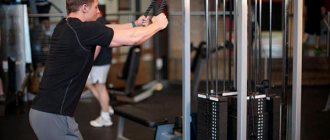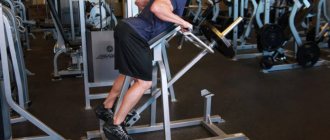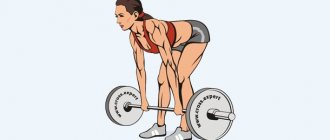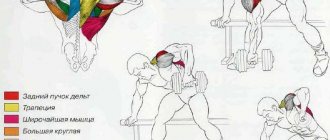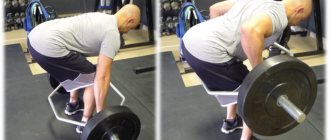For powerlifters, the bench press is a separate discipline, and in bodybuilding, the bench press is one of the most popular. Increasing its effectiveness guarantees the maximum effect from training and the achievement of the goals set for the athlete.
This can be achieved by performing the exercise in low repetitions. There are other movements that need to be performed to maximize the benefits you get from the barbell press. They must also be included in classes.
What training program can increase your bench press?
The proposed system is based on two options for classes. It is recommended to perform at least two workouts weekly. This is the optimal scheme. If recovery is fairly quick, you can devote up to four days a week to exercise. It all depends on the individual characteristics of the athlete’s body.
The first step towards improving your bench press performance is to determine your maximum. In other words, a bodybuilder needs to find his limit, that is, his record. This indicator becomes the main starting point for drawing up an individual training system.
To fully concentrate on the task at hand, you should focus only on the main task. Therefore, in the training program under consideration, pumping the lower body is completely excluded, and all emphasis is placed only on the upper body. To keep your leg muscles in good tone, it’s enough just to do squat warm-up exercises at the beginning of training or in any free time when you have it.
History of success
Kirill started going to the gym at the age of 15. Over the next year, the athlete gained 90 kg of weight. At the age of 17 he became a master of sports, and at 22 he set a record in the power biathlon - 380 deadlift and 310 bench press. The overall result is 690 kg. The athlete's height is 197 cm.
After this, the athlete delighted fans with records many times. The highest recorded result: squat - 400 kg, deadlift - 410 kg, bench press - 335 kg, the Russian athlete became world champion. Total weight without equipment is 1082.5 kg.
Sarychev's training program contains three five-hour sessions per week. The athlete performs many exercises, the main ones being squats, bench presses, push-ups, exercises with dumbbells, and performs a number of auxiliary exercises. He trains triceps on machines and uses barbells. Uses sports nutrition.
Training program to increase bench press results
When you have decided on your own repetition maximum, you can start training.
First training
- 1. Bench press (60% of 1 repetition maximum) – 1 warm-up set + 3 working sets of 5 repetitions – performed at maximum speed, training explosive strength;
- 2a. Close-grip bench press – warm-up set + 3 working reps of 5 reps – we also work in speed mode, strengthening the triceps and inner chest;
- 2b. Standing barbell press – 1 warm-up set + 3 working sets – strengthening the anterior deltoid muscles.
Options 2a and 2b are used alternately (in one workout only 2a, in the other only 2b). But if some muscle group is lagging behind you (triceps or deltoids), then use one of the options more often.
- 3. Wide grip pull-ups - 1 set with only your own weight for 7-8 repetitions, 2 set with additional weights for 6-8 repetitions, and the last set again with your own weight for the maximum number of repetitions.
- 4. Bent-over barbell rows – 2 warm-up sets + 3 working sets of 6-8 reps.
https://youtu.be/VegMB6md9Fg
Surovetsky Askold Evgenievich
Surovetsky Askold Evgenievich
System No. 1
Warm-up: 30x8, 45x6, 60x6, 70x5, 80x4, 84x3, 88x3
| put the squeeze on | |||||||||||
| No. tren | 92% | 96% | 100% | 92% | 90% | 88% | 86% | 84% | 82% | 80% | 100% |
| 1 | 2x4 | 2x2 | |||||||||
| 2 | 2 | 2 | 2x5 | 2x2 | 3x2 | ||||||
| 3 | 3 | 2x6 | 2x3 | ||||||||
| 4 | 2 | 1 | 1 | 2x3 | 2x3 | 3x3 | |||||
| 5 | 3 | 2x4 | 3x3 | ||||||||
| 6 | 2 | 2 | 2x5 | 3x3 | |||||||
| 7 | 2 | 2 | 1 | 2x3 | 2x2 | 3x4 | |||||
| 8 | 3 | 2 | 2x4 | 2x3 | |||||||
| 9 | 3 | 2 | 1 | 2x3 | 3x3 | ||||||
| 10 | 3 | 2 | 1 | 2x3 | 2x2 | 3x5 | |||||
11. 30%x10; 45%x8; 60%x6; 70%x3x5 12. 36%x8; 54%x6; 68%x5; 76%x4% 84%x3; 92%x2; 100%x1, penetration
An auxiliary exercise that is not similar to a movement is used more and more to strengthen ligaments, pump up, and in the strength cycle, almost half of it is done using auxiliary movements similar to the main one. Never do it to failure in the back room: do it for your own pleasure, not all the way, but with a reserve of 2-3 repetitions. Usually: on blocks up to 8 repetitions, with dumbbells and barbells - up to 6 repetitions. Approaches: one just trial and 3-4 main ones.
The only thing you can do after the bench press is: sitting (lying) flyes – 4 x 6, forward arm raises – 4 x 6, back, rear deltoid, biceps. Triceps can be done on the same day, followed by two days of rest: usually parallel bars and triceps pulleys. There is one movement that almost no one does, but in vain. These are push-ups. Hands should be positioned at grip width when pressing. The support of the legs should be higher than shoulder level. You can add weight to your back. And do push-ups (you get half-presses) 3-4 sets of 6 to 10 repetitions.
The last weight in training is performed with a pause on the chest for 2-3 seconds. The first approaches in workouts 1 to 10 are the same. The push-up is performed from a stand on the chest with a height of approximately 10-12 cm. The first number is approaches, the second is repetitions.
After completing system No. 1, move on to system No. 2.
System No. 2
| 36% | 54% | 68% | 76% | 80% | 84% | 88% | 92% | 88% | |
| 1 | 8 | 6 | 6 | 5 | 4 | 3 | 3 | 2x2 | 2x3 |
| 2 | 8 | 6 | 6 | 5 | 4 | 3 | 4x3 | ||
| 3 | 8 | 6 | 6 | 5 | 4 | 5x5 | |||
| 4 | 8 | 6 | 6 | 5 | 4 | 3 | 3 | 3x3 | 3x3 |
| 5 | 8 | 6 | 6 | 5 | 4 | 3 | 3x3 | ||
| 6 | 8 | 6 | 5 | 4 | 3 | 3 | penetration |
Is it possible to do presses in a T-shirt instead of push-ups with the same weight and number of repetitions?
If you work in a T-shirt, then it is better to work in it instead of push-ups.
presses in a T-shirt, increase the weight of the projectile? What maximum should you push off from - equipped or without?
Of course, push up in a T-shirt from the maximum in a T-shirt and take more than the maximum
When bench pressing in a T-shirt, what number of repetitions and approaches should I stick to?
Everything is the same according to the system, only on days with heavy weights, perform in a T-shirt after 80%
Do the bench press in a T-shirt work at full amplitude or just push-ups?
Strive for full amplitude, maintaining the desired trajectory of the barbell. But on the first approaches, the weight will be too small to lower completely onto the chest.
What schemes for squatting and deadlifting can be combined with bench press No. 1?
I don’t associate pressing systems with squats and deadlifts at all. I use any system. I believe that only the squat and deadlift are interconnected.
Sorry, maybe I don’t understand something, I have no experience working with systems of this kind... The weights according to the diagram are located like this: 92, 96, 100, 92%, etc. That is, first to increase, then to decrease... In that order and do it?
Yes, sure.
To what level should we push? Since the weight is considerable and the load is not bad, this is important.
In boosters, the descent goes to the possible level. But you shouldn’t lower more than half the distance; it’s better to add weight.
Is it reasonable to only do Zhno.2, without Zh.No.1?
You can repeat one system. This is not fundamentally important. I used to do this for Zh No. 2. Until you feel physically and psychologically saturated. Then you switch to another system, interest and desire appear again.
The question arose: why is there no support for the anterior deltoids and triceps in the Zh1 system, but there is one in the Record system? Although I do bench press here and there 3 times a week.
Because in W#1 all workouts put a lot of stress on the deltoids and triceps, and in “Record” heavy workouts alternate with light ones.
After push-ups my shoulders hurt. Can he do a hold or a negative instead of push-ups?
No need for negativity. Deductions are possible. Or give up boosters altogether. Instead, something for the triceps.
Is it possible to do overhead presses or dumbbell lateral raises using the 1/2 press system?
All other barbell hand presses are unnecessary. You can do lateral raises on the middle delta if you need it.
Please tell me, is it possible to replace the 11th workout with a speed press in bench press No. 1? If the preparation goes without surprises, I will have the 11th training session on Wednesday, and the competition on Sunday.
Under no circumstances, especially before competitions.
Squat. Bench press. Bench press
Advanced circuit
Here we use the same principles, adding light, medium and heavy workouts. In the remaining exercises we maintain linear progress. It will look like this:
Monday
- Heavy bench press - 85-90% of the one-time maximum for 4-5 reps in 5 approaches.
- Squats - 70-75% of the one-time maximum for 10 repetitions in 5-7 approaches.
- Pull-ups - 70-75% of the maximum in 5-7 approaches.
- Assistance (French press, swings or flyes) - 70-75% of the maximum for 10 repetitions in 3-5 approaches.
Thursday
- Average bench press - 70-75% of the maximum for 5 reps in 5-7 sets.
- Exercise for lagging muscle groups.
Saturday
- Light Press – 50% of max for 10 reps for 5 sets
- Squats with the addition of 2.5 kg or several approaches.
- Pull-ups with the addition of 2.5 kg or several approaches.
If you can’t add in squats and pull-ups, don’t add them or add them less often. Once a month, instead of a hard workout, we press 95–100% for 1–2 times in a large number of approaches.
Don’t forget to increase the load on every hard workout, because only with constant progress can these programs give results.
Principles of strength training
It is believed that to increase the maximum result in the bench press, you just need to press 1 time, or regularly do passes. However, practice shows that this approach, if effective, is not on a permanent basis.
Indeed, we will leave the postulate “To reap a lot, you need to reap a lot” intact. In building a strength result in the bench press, it is the bench press that is important, and not the auxiliary exercises, which we will talk about later. At the same time, we will move away from the standard practice of strength work and confidently state that for maximum results in the bench press for 1 rep you need to regularly press 4-6 reps.
This is also strength work, but increasing the number of repetitions to 4-6 allows you to remove the load from the central nervous system, which will “pass out” after a few weeks if you regularly push your maximum in each workout.
In addition, approaching a more or less solid result, we will be forced to abandon linear progress. With each added kilogram on the bar, we need to recover longer and put in more effort so as not to drive ourselves into overtraining.
We can confidently say, based on our own experience: the central nervous system cannot withstand long-term linear progress in strength work. The body may process such training through adaptation, but it is much more difficult to adapt the nervous system to overload.
Apathy towards training arises, and the sight of the barbell begins to make you vomit. Such overload of the central nervous system is less likely when working in several repetitions. Thus, we will build our training program on three principles:
1. Refusal from permanent work for a one-time maximum
2. Individuality of the work performed
3. Wave-like progress that will allow you not to overload your nervous system
Tips for beginners
Classes are carried out strictly under the supervision of a trainer or experienced athlete. There is a classic 5x5 training scheme. For it, they use such a weight that it can be used to perform five techniques of 5 approaches. The procedure for calculating weight for training:
An athlete benches 100 kg and wants to achieve another 100. To perform 5x5 exercises, you need to use no more than 80 kg. It is necessary for a beginner to train by feeling, but not by force. The first four exercises are light, then one heavy weight. They do three workouts a week, one of which is hard.
Description of classes
Kirill Sarychev’s training contains a set of exercises:
Monday – heavy squats with 90% load of maximum weight. Perform up to 5 approaches in total.
- Bench press.
- Squats.
- Biceps and triceps training.
- Extension of legs, arms.
Wednesday. A powerlifter performs back exercises:
- Deadlift – hold a weight between your legs and perform deep squats. Trains the broad back muscles.
- Exercises for the trapezius muscle.
- Hyperextension.
Friday program. Bench:
- Bench press heavy 3x5 sets.
- After this, squats are performed.
- Bench press 5x5 sets.
- Wiring.
- Pull-ups – 50 times. Can be divided into 4 approaches.
The athlete takes breaks between exercises, sometimes for 10 minutes.
Having achieved his current form, Kirill allows himself to do squats only a few times a week to maintain strength in his legs for subsequent deadlifts. The athlete does not use maximum weight during training, because after overload, muscle recovery takes about a month.



